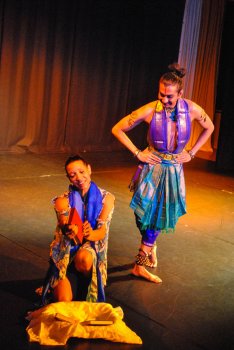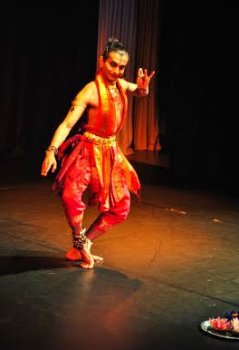
|   |

|   |
The male dancer in Three Goddesses - Dr. Chamu Kuppuswamy e-mail: c.kuppuswamy@sheffield.ac.uk December 19, 2013 Three Goddesses, an original story-telling production by Kala Sangam’s artistic associate, Shrikant Subramaniam, was a symbolic sociological account of the three most influential women in his life, laced with significance and import for the women in all our lives. Set in the image of the trinity Goddesses, Saraswathi, Lakshmi and Parvathi, Shrikant’s three Goddesses were Shrimathi Sheshammal (his grandmother), Rukmini Devi Arundale (his teacher, whose mother, incidentally, was also called Sheshammal!) and Uma (his mother). The production, a collaboration between people and between storytelling and dance, was staged on the 30th of November 2013 at Kala Sangam, Bradford. It was a story about a dancer told by two story tellers, Shrikant and Ayo Jones. They addressed the audience mainly speaking in English, delightfully interspersed with Tamil at one point. It was wonderful to hear Sanskrit and Tamil lyrics, especially written for this production by Dr. Geetha Upadhyaya, director of Kala Sangam. Three Goddesses captured different eras and different geographical realities. Of course, it was hard to miss the presence of Bharatanatyam on stage. The stage set-up, story and the story teller were all linked to Bharatanatyam. Shrikant’s approach to performance was as a story teller utilising the vocabulary of dance. Shrikant was adapting his icon Arundale’s panache for innovation. She was influenced by Western productions of a large scale, and brought dance drama productions on stage at Kalakshetra in Madras, many decades ago. And here he was, a Kalakshetra alumnus in England, exploring how to speak to a multicultural audience in Bradford and beyond. 

Shrikant was using a technique very much familiar in classrooms. He used the narrative to convey information, before internalising it through dance. But the dance never really lasted long enough. By the time one got into the dance, the narrative intruded. Alas, this wasn’t helped by the stage, which was tantalisingly set for dance, creating yet more expectations for dance. One wanted more dance, but got less, especially as the technique was superb, flawless Kalakshetra. The adavus were crisp, neat and graceful. The alarippu shone bright amongst the dance elements of the evening. Shrikant’s choice of costume was tasteful. A blue theme pervaded the first half, and the striking red costume after the interval added majesty to the portrayal of Parvathi or Shakti. Such glitter didn’t accompany Shrikant’s abhinaya that evening. His abhinaya was slightly more engaging after the interval, but for the most part, he was expressive when he spoke. A neutral and impenetrable smile was more a sign of awareness of the body than emotion. “I was her shadow,” he said of his grandmother. Did he have a tinge of regret beneath that admiration when he said he was her shadow? What was the emotion or emotions? What was the sthayi bhava one should read into his portrayals? Magic and mystery, memories and mothers, words and wisdom, songs and stories, wonderful, splendid… and so the Word continually ruled the stage on an evening where it should have shared it equally with dance. The narrative does its job quick, but dance takes longer to engage and needs more space if it were to really affect the audience and shine. If this difference is not recognised and embraced in a collaborative effort between the arts, it impedes the unfolding of the dance, leaving a less-than-satisfied rasika. It would be great if more thought were to be given to the purpose of the collaboration between storytelling and Bharatanatyam, which are in essence two different ways of storytelling. Shrikant received superb vocal and instrumental support from resident musician Vijay Venkat, and Prakash from London played the mridangam supportively. On the plus side, the combination of narrative and dance went down very well with the audience, if the post-performance Facebook posts are anything to go by. Well, a happy audience is good for the arts! Students from Kala Sangam’s dance and music academy performed short pieces; senior students were drawn into the Three Goddesses performing a Thillana in Bilahari, choreographed by Rukmini Devi Arundale. Kala Sangam knows its audience very well, and had pitched it just right, a testimony to its continued flourishing 20 years after its establishment. It didn’t go unnoticed that along with the three Goddesses, there was a fourth in the making for Shrikant, Dr. Geetha Upadhyaya, his mentor at Kala Sangam. Now, with renewed energy, it is hoped there will be more coming out of there, given the boost in its artistic capacity in recent months. “Of course, with 2 wonderful artists Kala Sangam must give more - so watch the space!” says Geetha Upadhyaya on Kala Sangam Facebook. So here’s to the future and some great shows at Kala Sangam. |